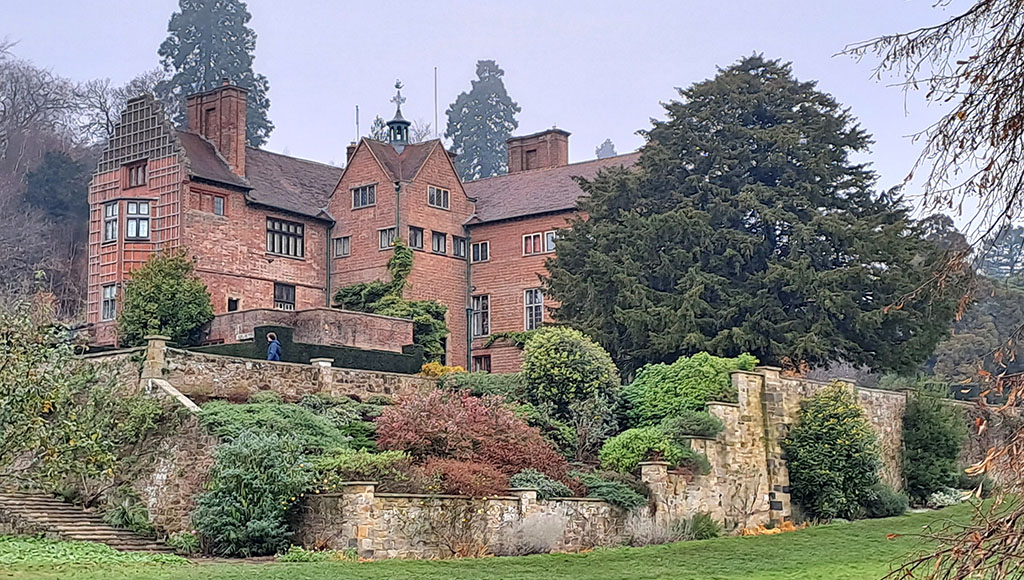“A day away from Chartwell is a day wasted” – Winston Churchill
On a miserable cloudy, wet late November day, we joined the queue of people outside the front door of Chartwell, Winston Churchill’s family home near Westerham in the Weald of Kent. Although shivering with cold as we stood outside, we soon warmed up as we entered the building. There were Christmas trees in most of the rooms and the atmosphere was seasonal and cheerful. We were about to discover something of the extraordinary life of one of the world’s most famous politicians and leaders.
During our tour, we learned that Winston married Clementine Hozier in 1908 after a whirlwind romance. She devoted her life to her husband and supported him through the most turbulent times and events of the 20th century. Their first decade of marriage gave them four children, Diana, Randolph, Sarah and Marigold. Tragically the youngest, Marigold, died at the age of two. Soon afterwards, Clementine gave birth to their fifth child Mary. It was at this time that Churchill bought Chartwell for the princely sum of £5,000 in 1922.
Chartwell was Churchill’s home for over 40 years. He lived there until just before his death in 1965. However, it was in the 1930s, when Churchill was away from political office, that this beautiful property became the centre of his universe. This period was often called his ‘wilderness years’.
In Chartwell, he gathered his friends and sympathisers to help him campaign against German re-armament after the First World War and the British Government’s response of appeasement. He composed speeches, wrote books and he painted. He worked tirelessly on his superb garden, constructing lakes, a natural swimming pool and even taught himself brick-laying!
During the Second World War, Chartwell was empty most of the time, but Churchill returned after losing the 1945 election. In 1953, when he was once again Prime Minister, it became his refuge when he suffered a debilitating stroke. In October 1964, he left for the last time, dying in his London home in January 1965.
The house was acquired by the National Trust in 1946, as, at the time, financial difficulties forced Churchill to consider selling Chartwell. Funds for the purchase were raised by a consortium of his friends on the condition that the Churchills retained a life-tenancy. Although a Grade 1 Listed Building, Chartwell is important for its historical significance rather than its architectural merit.
Our tour began in Lady Churchill’s Sitting Room by the front door. It is a charming small room and has an adjoining terrace that offers glorious views of the garden and the Kent Weald. We noticed, perhaps with Christmas just around the corner, that one of the chairs was bedecked with dolls and toys! There is a striking portrait of Churchill over the mantelpiece.
This room leads into the Hall, where the great and the good of the 20th century would have been greeted. A visitors’ book, a document of enormous significance, sits in a protected glass case and, nearby, there is a stand holding an array of his walking sticks.
The Library at Chartwell had an important pre-war role as a centre for meetings and vital transfers of intelligence concerning Nazi Germany’s growth in military strength and preparation for war. Underneath the desk, and difficult to see, sits the despatch box that used to be on the central table in the House of Commons chamber during the Second World War. It was later gifted to Churchill, as it was from this box that he delivered his most famous speeches.
Next door was the Secretaries’ Office – described by a former incumbent as “where it all happened, the hub of the whole place”. It was a hive of activity from morning until night, as Winston dictated some of his millions of words for his books, articles, speeches and correspondence. In the centre of the desk is the Remington Noiseless Typewriter – at the forefront of technology at the time! He didn’t like the clattering sound that normal typewriters made!
The upstairs was not open at the time of our visit, so our tour continued into the Drawing Room, undoubtedly our favourite room in the house. This was the heart of the family home, the décor heavily influenced by Clementine, with its pastel shades of delicate floral textiles and very personal touches. Grouped around the fireplace are sofas and chairs on which the family and guests would rest in an informal atmosphere. We could easily imagine Winston’s guests relaxing in this room after dinner, each brandishing a cigar and a glass of the very best cognac!
We felt that the Dining Room, on the lower ground floor, had a real connection with the outdoors with its large arched windows overlooking the beautiful gardens. Every detail was considered. The tables were round to ensure that no guests were excluded from conversation. Churchill said that the chairs should be “comfortable and give support to the body when sitting up straight” and “should certainly have arms, which are an enormous comfort when eating your meal”. He preferred simple food, with French cuisine as a favourite, typically served with champagne.
Nearby was the Kitchen, a room of great value to Churchill as dining was a vital part of his life. He thought that “food and drink were the tools of politics as much as words and speeches” and installed a very large Aga range. Interestingly, Clementine described herself as “a theoretical rather than a practical cook”. It seems that the menus could range from extravagant, like Chateaubriand steak with Provençale sauce down to more modest offerings such as Irish stew.
Before leaving the building, we spent time in the Exhibition Room which contained more fascinating information about his life, including the family tree, his period as a journalist and war correspondent, his undoubted literary skills and his hobby as an artist of some merit. It just remained for us to look at the picturesque Golden Orfe Fish Pond, one of his favourite places, then visit his artist studio just across the garden. He began his love of painting at the age of 40 and his work included landscapes, interior scenes, portraits and still life. His studio houses around 180 of his paintings. He always regarded himself as an amateur and was very content with the hobby he called his “joy ride in a paint box”.
When most people think of Winston Churchill, they imagine him as one of the great heroes of the 20th century. Even the mention of his name instantly evokes his bulldog image, V for victory symbol, and brilliant speeches. However, some historians say that if was not for Hitler, he would be remembered as a failure! Churchill warned against Hitler when no-one was willing to listen, then led Britain from its most desperate hour to victory. During his long pre-war career though, he made many mistakes, from advocacy for the disastrous Gallipoli campaign in the First World War, policies on Ireland, mismanagement of the British economy between the wars and opposition to Mahatma Gandhi and Indian Independence. Perhaps we can sum it all up by saying that ‘when Churchill was wrong, he was very wrong, but when he was right, he was very right!’
By Nigel Wright
|| features@algarveresident.com
Nigel Wright and his wife Sue moved to Portugal 19 years ago. The couple lived and worked in the Far East and Middle East during the 1980s and 90s. Although now retired, Nigel still continues to travel and seek out new cultural experiences. His other interests include tennis, gardening and photography.




















